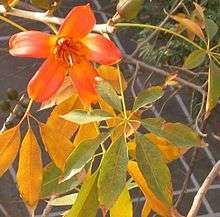Bombax
Bombax is a genus of mainly tropical trees in the mallow family. They are native to western Africa, the Indian subcontinent, Southeast Asia, and the subtropical regions of East Asia and northern Australia. It is distinguished from the genus Ceiba, which has whiter flowers.
| Bombax | |
|---|---|
 | |
| Bombax ceiba flower | |
| Scientific classification | |
| Kingdom: | Plantae |
| Clade: | Tracheophytes |
| Clade: | Angiosperms |
| Clade: | Eudicots |
| Clade: | Rosids |
| Order: | Malvales |
| Family: | Malvaceae |
| Subfamily: | Bombacoideae |
| Genus: | Bombax L.[1] |
| Species | |
|
See text | |
| Synonyms | |
|
Eriodendron DC. | |
Common names for the genus include silk cotton tree, simal, red cotton tree, kapok, and simply bombax. Currently four species are recognised, although many plants have been placed in the genus that were later moved.[2]
The genus is best known for the species Bombax ceiba, which is widely cultivated throughout tropical and sub-tropical regions of the world. It is native to southern and eastern Asia and northern Australia.
Bombax species are used as food plants by the larvae of some Lepidoptera species including the leaf-miner Bucculatrix crateracma which feeds exclusively on Bombax ceiba.
The tree appears on the flag of Equatorial Guinea.
Description
-_fallen_flower_at_ground_in_Kolkata_W_IMG_4121.jpg)
Bombax species are among the largest trees in their regions, reaching 30 to 40 metres in height and up to three metres in trunk diameter. The leaves are compound with entire margins and are deciduous, being shed in the dry-season. They measure 30 to 50 cm across and are palmate in shape with five to nine leaflets. The calyx is deciduous, meaning it does not persist on the fruits. They bear five to ten cm long red flowers between January and March while the tree is still leafless. The stamens are present in bundles in two whorls, while the staminal column lacks lobes. The ovary matures into a husk containing seeds covered by a fibre similar to that of the kapok (Ceiba pentandra) and to cotton, though with shorter fibres than cotton, that does not lend itself to spinning, making it unusable as a textile product.[3]
Species
Plants of the World Online currently includes:[4]
- Bombax albidum Gagnep.
- Bombax anceps Pierre (syn. B. kerrii & B. valetonii)
- Bombax blancoanum A.Robyns
- Bombax buonopozense P. Beauv.
- Bombax cambodiense Pierre
- Bombax ceiba L. (syn. B. thorelii Gagnep.)
- Bombax costatum Pellegr. & Vuill.
- Bombax insigne Wall. (syn. B. scopulorum)
Formerly included species
- Ceiba aesculifolia (Kunth) Britten & Baker (as B. aesculifolium Kunth)
- Ceiba pentandra (L.) Gaertn. (as B. pentandrum L.)
- Cochlospermum orinocense (Kunth) Steud. (as B. orinocense Kunth)
- Cochlospermum religiosum (L.) Alston (as B. gossypium L.)
- Cochlospermum vitifolium (Willd.) Spreng. (as B. vitifolium Willd.)
- Ochroma pyramidale (Cav. ex Lam.) Urb. (as B. pyramidale Cav. ex Lam.)
- Pachira aquatica Aubl. (as P. macrocarpum (Schltdl. & Cham.) K.Schum.)
- Pachira emarginata A.Rich. (as B. emarginata (A.Rich.) C.Wright)
- Pachira insignis (Sw.) Savigny (as B. affine (Mart. & Zucc.) Ducke)
- Pseudobombax ellipticum (Kunth) Dugand (as B. ellipticum Kunth)
- Pseudobombax grandiflorum (Cav.) A.Robyns (as B. cyathophorum (Casar.) K.Schum.)
- Pseudobombax septenatum (Jacq.) Dugand (as B. heptaphyllum L.)[2]
- Rhodognaphalon mossambicense (A.Robyns) A.Robyns[5] (as Bombax mossambicense A.Robyns[2])
References
- "Genus: Bombax L." Germplasm Resources Information Network. United States Department of Agriculture. 2007-10-05. Archived from the original on 2013-06-15. Retrieved 2013-04-27.
- "GRIN Species Records of Bombax". Germplasm Resources Information Network. United States Department of Agriculture. Archived from the original on 2015-09-24. Retrieved 2013-04-27.
- Beentje, Henk; Smith, Sara (2001), "Plant Systematics and Phytogeography for the Understanding of African Biodiversity", Systematics and Geography of Plants, 71 (2): 284–286, doi:10.2307/3668673, ISSN 1374-7886, JSTOR 3668673
- Plants of the World Online (POWO): Bombax L. (retrieved 10 April 2020)
- Plants of the World Online (POWO): Bombax mossambicense A.Robyns (retrieved 10 April 2020)
Further reading
- Robyns, André (March 31, 1963), "Essai de monographie du genre Bombax s.l. (Bombacaceae)", Bulletin du Jardin botanique de l'État a Bruxelles (in French), Bulletin du Jardin botanique de l'État a Bruxelles, Vol. 33, No. 1, 33 (1): 1–144, doi:10.2307/3667210, JSTOR 3667210
External links
| Wikimedia Commons has media related to Bombax. |
| Wikispecies has information related to Bombax |